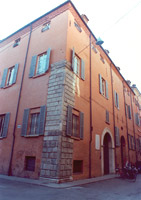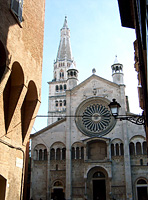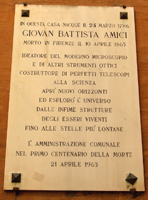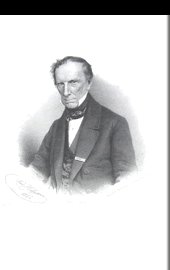A biography of Giovanni Battista Amici
1786-1825 - His studies, his teaching, his workshop - return to index
return to index
Giovanni Battista Amici was born in Modena on 25 March, 1786. His father, Giuseppe Amici Grossi, was director of General Accounting and of the Census Office of the Este Dukedom; his mother, Maria Dallocca, was a “young woman without dowry”.
In 1802, with the establishment of the Italian Republic, the French abolished almost all the universities and substituted them with “licei dipartimentali”. University subjects were taught there, but in order to be awarded a university degree the student had to attend one of the two universities allowed to remain open, in Bologna and Pavia. It was for this reason that in the academic year 1802-1803 Amici enrolled in Architectural Engineering and attended classes for the first year in the University which had been closed by the French. He then continued studying in the Liceo Dipartimentale del Panaro, which had been officially opened in early 1804.
He studied, among other topics, Introduction to Sublime Calculus, Sublime Calculus, Mechanics and Hydromechanics with the mathematician Paolo Ruffini (1765-1822), famous above all for his Teoria delle equazioni (Theory of Equations).
 He finished studying in Modena, and in 1806 he married Teresa Tamanini (1790-1843), daughter of Antonio Tamanini, bookseller. Her dowry included the Villa della Madonnina, outside of the city, where the family passed the summer months and where Giovanni Battista carried out his astronomical observations. His wedding gift, instead, was the house in Piazza Grande in which there was the shop of the historic Stamperia Reale Eredi Soliani (Royal Printers Soliani Heirs) inherited from the Amici family. Giovanni Battista had three children with Teresa: Vincenzo (1807-1874), Elena (1808-1845) and Valentino (1810-1863).
He finished studying in Modena, and in 1806 he married Teresa Tamanini (1790-1843), daughter of Antonio Tamanini, bookseller. Her dowry included the Villa della Madonnina, outside of the city, where the family passed the summer months and where Giovanni Battista carried out his astronomical observations. His wedding gift, instead, was the house in Piazza Grande in which there was the shop of the historic Stamperia Reale Eredi Soliani (Royal Printers Soliani Heirs) inherited from the Amici family. Giovanni Battista had three children with Teresa: Vincenzo (1807-1874), Elena (1808-1845) and Valentino (1810-1863).
Due to obligatory military service Amici could not enrol at the University of Bologna until 5 January, 1808. On 2 June of the same year, he sat the exam to become an Architectural Engineer. The diploma from the University of Bologna is dated 9 June,  1808. On 4 January, 1811 Giovanni Battista Amici was assigned the Chair of Algebra and Geometry at the Liceo Dipartimentale del Panaro, and in the academic year 1813-1814 he was also asked to teach Trigonometry.
1808. On 4 January, 1811 Giovanni Battista Amici was assigned the Chair of Algebra and Geometry at the Liceo Dipartimentale del Panaro, and in the academic year 1813-1814 he was also asked to teach Trigonometry.
The University was reopened in 1815 when the Duke returned to power. Amici had acted as Regent of the Liceo during the transition from the Napoleonic period to the return to power of the Este family, and he was now given the position of professor of Geometry, Algebra and Plane Trigonometry in the Philosophy Faculty. In 1825 he became the Professor Referring to the Minister on Progress in Physics and Mathematics. He was respected by scholars and rulers alike, and on 30 July, 1825 the Duke dispensed him from teaching while maintaining his rank and his salary. This allowed him to dedicate all his efforts to his instruments and observations.
 The Archduke Massimiliano Giuseppe (1782-1863), brother of Francesco IV, Duke of Modena, was a great admirer of Amici. He never failed to visit the workshop in Contrada de' Servi, numbers V 1829 - U 1830 where there was also the home of Amici and the printing activity. The Archduke often accompanied rulers and royals linked to the Austrian dynasty, like the Emperor Francesco I, Vittorio Emanuele I of Savoia, Leopold II from Tuscany, Gustave of Sweden and the Duke of Modena himself. Massimiliano was a competent scholar and he played an important role in making Amici's invention known outside of Italy, especially in Vienna and in the circle of David Brewster in Edinburgh.
The Archduke Massimiliano Giuseppe (1782-1863), brother of Francesco IV, Duke of Modena, was a great admirer of Amici. He never failed to visit the workshop in Contrada de' Servi, numbers V 1829 - U 1830 where there was also the home of Amici and the printing activity. The Archduke often accompanied rulers and royals linked to the Austrian dynasty, like the Emperor Francesco I, Vittorio Emanuele I of Savoia, Leopold II from Tuscany, Gustave of Sweden and the Duke of Modena himself. Massimiliano was a competent scholar and he played an important role in making Amici's invention known outside of Italy, especially in Vienna and in the circle of David Brewster in Edinburgh.
Bibliography
F. Storchi, Elogio del Cav. Prof. Giambattista Amici, “Annuario scolastico della R. Università degli Studi di Modena per l'anno accademico 1878-79”; P. Di Pietro, Gli anni modenesi di G. B. Amici, “Giornale di Fisica”, 2/3-1988.
